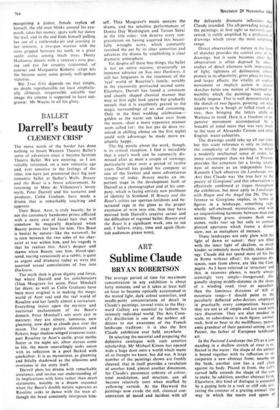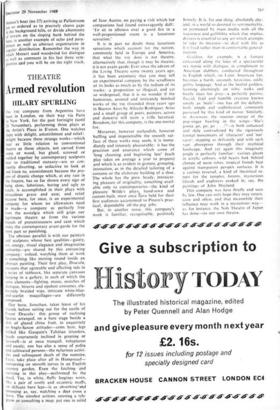ART
Sublime Claude
BRYAN ROBERTSON
The average period of time for maximum concentration in any exhibition is about forty minutes; and as it takes at least half an hour to become optically accustomed to the muted light, dark colour sonorities, and needle-point concentrations of detail in Claude's paintings, several visits to the Hay- ward Gallery are essential to fathom his intensely individual world. The Arts Coun- cil's distillation is one of the noblest ad- ditions to our awareness of the French landscape tradition: it is also the first Claude exhibition ever held, anywhere.
In selecting the material and preparing the definitive catalogue with such sensitive scholarship, Mr Michael Kitson has opened wide a huge door onto a world which many of us thought we knew, but did not. A large number of the paintings shown are freshly cleaned; that in itself provides a revelation of another kind, almost another dimension, for Claude's passionate sobriety of colour, total modulation, and structure, can all become relatively inert when muffled by yellowing varnish. At the Hayward the paintings now exude the still, classical con- centration of mood and incident with all
the delicately dramatic inflexions that Claude intended. The all-pervading mood of the paintings, at first sight so narrowly con ceived, is richly amplified by a profusion of drawings which cover the most surprism: range.
Direct observation of nature in the form of sketches provides the central core of the drawings, but it soon becomes clear that observation is often deposed by ideas studies of detail alternate with impressions of light; tightness of delineation, almost prosaic in its objectivity, gives place to loose- and larger effects; the vitality of explicit movement or implicit action in several sketches belies any notion of becalmed irn mobility which the paintings may super- ficially impose. This is well demonstrated in the sketch of two figures, pointing, on what appears to be a bough or felled trunk of a tree, thus bringing the latters idylls of Watteau to mind. Here is a freedom of ex- pansive movement accompanied by a breadth of tonal mass that was very much to the taste of Alexander Cozens and other English water-colourists.
The drawings could take up all our time but this scant reference is only to indicate the complexity of the paintings, in which a modestly intellectual sense of order, far more circumspect than we find in Poussin.
provides the armature for a loving aware- ness of nature as an independent force.
Kenneth Clark observes (in Landscape into Art) that Claude was 'the true heir to the poetry of Giorgione' and this observation is effectively confirmed at stages throughout the exhibition, but most aptly in Landscape with Hagar and the Angel (no 29). The re- ference to Giorgione implies, in terms of figures in a landscape, something rapt. wholly self-enclosed, mysterious, and with an unquestioning harmony between man and nature. Sheep graze, streams flash over stones, rocks rear up but only to contain pierced apertures which frame a distant view, not as metaphors of menace.
These landscapes not only glow with the light of dawn or sunset: they are filled with the inner light of idealism, so much kinder, so infinitely more flexible, than ideol- ogy. Claude did not spend most of his life in Rome without effect: his spacious dis- tances, seen from above, are like the Cam- pagna. As I have referred to 'structure' and this, in recessive planes, is nearly always seemingly very simple—foreground; dia- gonally sloping middle-distance in the shape of a winding road, river or aquaduct; then the luminous distances of hill or mountain range—I should point to the peculiarly deflected echo-devices employed in practically every composition, because they are not at all simple and are used with rare discretion. They are also modest in scale, so subordinate is each figure, animal. rock, bird or boat to the mellifluous, panor- amic grandeur of their pastoral setting, as in Patinir, the father of European landscape art.
In the Pastoral Landscape (no 25) as a cow standing in a shallow stretch of river is re-
flected in the water: the shape of the animal is bound together with its reflection to in- corporate a new abstract form; nearby on the bank, another cow has a calf close against its body. Placed in front, the call's curved belly extends the shape of the cow to make, by addition, another abstract form.
Elsewhere, this kind of dialogue is extended by a gaping hole in a rock or cliff side mir-
roring the contour of a grazing animal. The way in which the masts and spans of
Aeneas's boat (no 37) arriving at Pallanteum are so ordered as to precisely cleave gaps ID the background hills, or divide abutments of towers on the sloping bank behind the boat, is another example of echo and para- phrase as well as abstract organisation in angular distribution. Remember the way in which Mozart used woodwind for dialogue as well as comment in his last three sym- phonies and you will be on the right track.











































 Previous page
Previous page